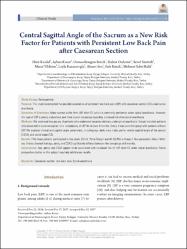Central sagittal angle of the sacrum as a new risk factor for patients with persistent low back pain after caesarean section

View/
Access
info:eu-repo/semantics/openAccessDate
2017Author
Kazdal, HızırKanat, Ayhan
Batçık, Osman Ersagun
Özdemir, Bülent
Şentürk, Şenol
Yıldırım, Murat
Kazancıoğlu, Leyla
Şen, Ahmet
Batçık, Şule
Balık, Mehmet Sabri
Metadata
Show full item recordCitation
Kazdal, H., Kanat, A., Batcik, O. E., Ozdemir, B., Senturk, S., Yildirim, M., Kazancioglu, L., Sen, A., Batcik, S., & Balik, M. S. (2017). Central Sagittal Angle of the Sacrum as a New Risk Factor for Patients with Persistent Low Back Pain after Caesarean Section. Asian spine journal, 11(5), 726–732. https://doi.org/10.4184/asj.2017.11.5.726Abstract
Study Design: Retrospective. Purpose: This study investigated the possible association of persistent low back pain (LBP) with caesarean section (CS) under spinal anesthesia. Overview of Literature: Many women suffer from LBP after CS, which is commonly performed under spinal anesthesia. However, this type of LBP is poorly understood, and there is poor consensus regarding increased risk after spinal anesthesia. Methods: We examined two groups of patients who underwent cesarean delivery under spinal anesthesia. Group I included patients who presented to a neurosurgical clinic complaining of LBP for at least 6 months. Group II was a control group with patients without LBP. We analyzed clinical and sagittal angle parameters, including age, body mass index, parity, central sagittal angle of the sacrum (CSAS), and sacral slope (SS). Results: Fifty-three patients participated in this study: 23 (43.1%) in Group I and 30 (56.9%) in Group II. Non-parametric Mann-Whitney U-tests showed that age, parity, and CSAS significantly differed between the two groups at 6 months. Conclusions: Age, parity, and CSAS appear to be associated with increased risk for LBP after CS under spinal anesthesia. Future prospective studies on this subject may help validate our results.

















